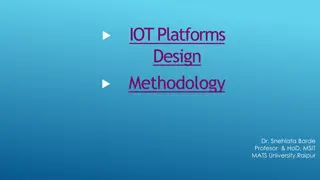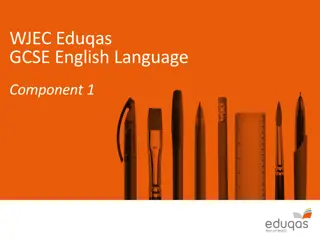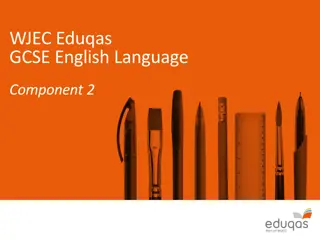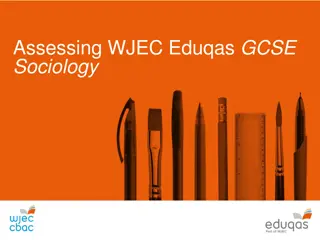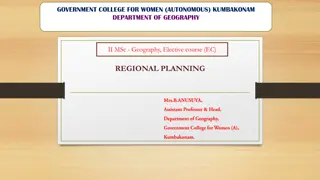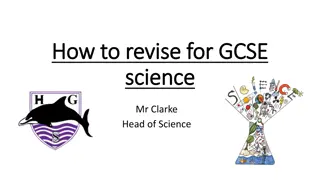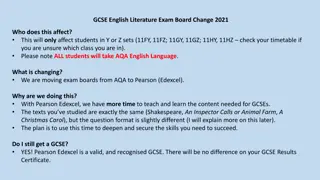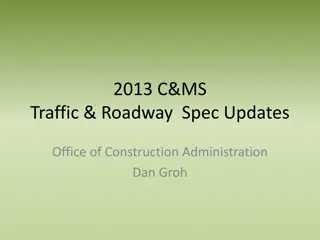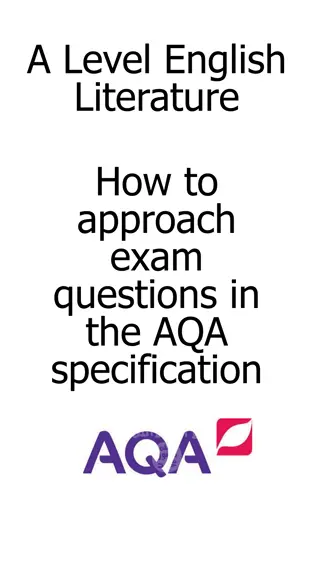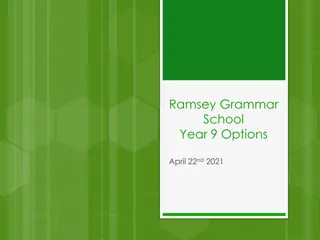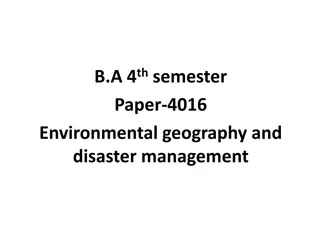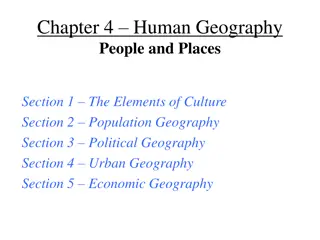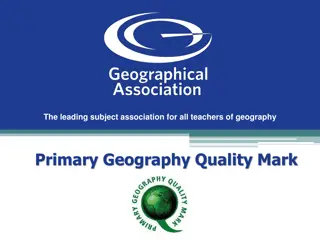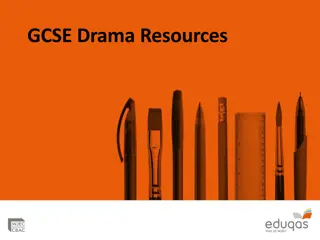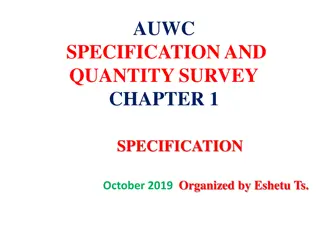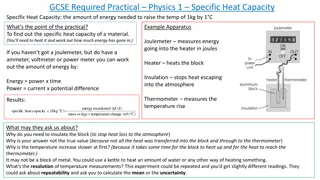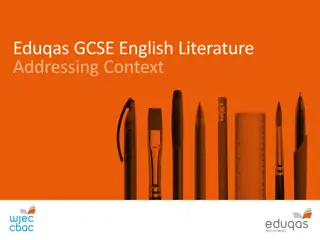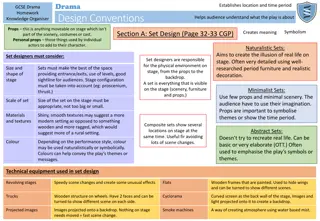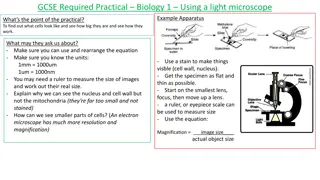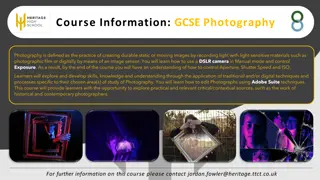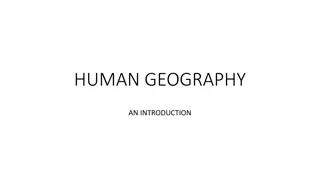Eduqas GCSE Geography Specification Overview
Welcome to the online meeting of the Eduqas regional team! This session provides information on the GCSE Geography Specification, including changes for 2021. The ethos of the qualification emphasizes developing learners' geographer thinking skills. The course is divided into three components covering various themes and skills. Fieldwork requirements have been updated, and the examination format has been adjusted. Contact details for further inquiries are provided.
Download Presentation

Please find below an Image/Link to download the presentation.
The content on the website is provided AS IS for your information and personal use only. It may not be sold, licensed, or shared on other websites without obtaining consent from the author. Download presentation by click this link. If you encounter any issues during the download, it is possible that the publisher has removed the file from their server.
E N D
Presentation Transcript
Welcome to our online meeting #eduqasrepteam
Welcome Thank you for attending the Eduqas regional team online session today. Please remember to turn your audio and video off. If you have questions, please use the Chat function or, if this is not available on your device, email us on hugh.lester@wjec.co.uk. We will answer as many as we can in the second half. Sessions on a variety of qualifications and topics continue until December. Follow the Twitter hashtag #eduqasrepteam to find out more. Eduqas regional team: here to support you Email hugh.lester@wjec.co.uk to be put in touch with the rep for your area.
Eduqas GCSE Geography Spec A Information for new centres
The Specification GCSE Specification Version 2 updated Jan 2019 Detailed information and guidance
2021 What is different? What are the changes? What does this mean? There is no requirement for centres to provide a written declaration that students have been given opportunity undertake fieldwork. There is no requirement to complete off site fieldwork. Fieldwork should still integrated into teaching. Some centres may choose to undertake fieldwork on site, in the locality or virtually to prepare students for the assessment. Exam questions will not relate to the student s own fieldwork. There will be no examination questions directly relating to student s own fieldwork on Component 3 (usually the last question in Part A and B). There will be questions related to unfamiliar fieldwork (as in previous examinations) which will assume that student s are acquainted with the enquiry process. The Component 3 paper in 2021 will be 1 hour 15 minutes.
Ethos The overarching ethos of this qualification is that learners should develop the ability to think like a geographer . Learners will develop the skills necessary to conduct framed enquiries in the classroom and in the field in order to develop their understanding of specialised geographical concepts and current geographical issues. Eduqas GCSE Geography A develops an enquiry approach to the study of geographical information, issues and concepts. It is based on the principle that geographical education should enable learners to become critical and reflective thinkers by engaging them actively in the enquiry process. Content is organised around key questions and learners should develop the ability to pose geographical questions of their own.
Overview The course is divided into the three components (exams), each of the components cover specific themes as well as geographical skills and mathematical techniques: Component 1: Changing Physical and Human Landscapes Component 2: Environmental and Development Issues Component 3: Applied Fieldwork Enquiry.
Component 1 - Changing Physical and Human Landscapes 1. Landscapes and Physical Processes 2. Rural-Urban Links Core Themes Learners should study both core themes and spend a minimum of 23 GLH on each theme. 3. Tectonic Landscapes and Hazards 4. Coastal Hazards and their Management Options Learners should study one of these options themes which add breadth of knowledge to the core and spend a minimum of 9 GLH on the options.
Component 1 - Changing Physical and Human Landscapes Core Theme 1 - Landscapes and Physical Processes This theme covers classic physical geography of rivers and landforms but with an emphasis of the interconnectedness of humans with physical landscapes. Key Idea 1.1: Distinctive landscapes of the UK Key Idea 1.2: Landform process and change in two different and distinctive landscapes of the UK Key Idea 1.3: Drainage basins of the UK Areas of specific study: one distinctive landscape where environmental challenges have been created by humans Studies of both river and coastal landscapes of the UK where landforms and rates of change are significantly different Study of the causes and effects of flooding in at least one location in the UK
Component 1 - Changing Physical and Human Landscapes Core Theme 2 Rural-Urban Links This theme covers classic human geography of rural and urban areas, looking at how changes have occurred at a local and global scale. Key Idea 2.1: The urban-rural continuum in the UK Key Idea 2.2: Population and urban change in the UK Key Idea 2.3: Urban Issues in contrasting global cities Areas of specific study: Issues in one brownfield context (urban regeneration) and one greenfield context Two global cities. One located in either a low income country (LIC) or newly industrialised country (NIC) and the other located in a high income country (HIC)
Component 1 - Changing Physical and Human Landscapes Optional Theme 3 Tectonic Landscapes and Hazards This theme covers classic physical geography of tectonics. Including formation of tectonic landscapes, how human interaction and the risks reduced. Key Idea 3.1: Tectonic processes and landforms Key Idea 3.2: Vulnerability and hazard reduction Areas of specific study: Include one located example of a volcanic hazard and one located earthquake event
Component 1 - Changing Physical and Human Landscapes Optional Theme 4 Coastal Hazards and their Management This theme covers classic physical geography of coasts. It covers vulnerable coastal communities and how they are managed with the overarching concept of sustainability. Key Idea 4.1: Vulnerable coastlines Key Idea 4.2: Managing coastal hazards Areas of specific study: Study one low lying coastline at risk of sea level rise
Component 2 Environment and Development Issues 5. Weather, Climate and Ecosystems 6. Development and Resource Issues Core Themes Learners should study both core themes and spend a minimum of 23 GLH on each theme. 7. Social Development Issues 8. Environmental Challenges Options Learners should study one of these options themes which add breadth of knowledge to the core and spend a minimum of 9 GLH on the options.
Component 2 Environment and Development Issues Core Theme 5 - Weather, Climate and Ecosystems This theme covers physical geography of weather and interaction within a range of ecosystems. Key Idea 5.1: Climate change during the Quaternary period Key Idea 5.2: Weather patterns and process Key Idea 5.3: Processes and interactions within ecosystems Key Idea 5.4: Human activity and ecosystem processes Areas of specific study: One located low pressure hazard and one located high pressure hazard Tropical rainforest ecosystem and its climate and one other contrasting biome Features of one located small scale ecosystem in the UK One environment used for energy production
Component 2 Environment and Development Issues Core Theme 6 Development and Resource Issues This theme covers human geography of development at different scales and the concept of globalization. Key Idea 6.1: Measuring global inequalities Key Idea 6.2: Causes and consequences of uneven development at the global scale and within one low income country (LIC) and one newly industrialised country (NIC). Key Idea 6.3: Water resources and their management Key Idea 6.4: Regional economic development Areas of specific study: Two economically developing countries, LICs and NICs for Key Ideas 6.2 and 6.4 How aid from government and NGOs can help reduce inequality in one LIC OR one NIC
Component 2 Environment and Development Issues Optional Theme 7 Social Development This theme covers human geography of development. It focuses primarily on issues in sub- Saharan Africa and South Asia and how these are tackled on a local and global scale. Key Idea 7.1: Measuring social development Key Idea 7.2: Consequences and responses to uneven social development Areas of specific study: Tackling of development issues at a local scale in one country in sub-Saharan Africa/Asia Tackling of health issues at a local scale in one country in sub-Saharan Africa
Component 2 Environment and Development Issues Optional Theme 8 Environmental Challenges This theme covers environmental geography., linking consumerism and the way we live our lives and it s impact on the global environment. Key Idea 8.1: Consumerism and its impact on the environment Key Idea 8.2: Management of ecosystems Areas of specific study: Effects in the UK and in one contrasting environment of climate change Management to reduce tourism s negative impacts on the environment and water resources of two contrasting environments to include tropical coastline/coral reefs
Component 3 Applied Fieldwork Enquiry Focus is on the specific fieldwork methodology, representation and analysis. The specific methodology changes every year Part A Question on your own fieldwork Novel contexts Focus on fieldwork enquiry will be used to investigate the specific concept. The specific concept changes every year Part B Question on your own fieldwork Novel contexts Application to broader UK context Part C A decision is made and justified.
Fieldwork approaches 2018-2024 The methodological approach and conceptual frameworks for component 3 change every year and therefore the focus of your 2 sessions of fieldwork will need changing annually. Changing your fieldwork without causing too much work is a challenge. Year of assessment Methodological approach Conceptual framework 2018 Use of transects Sphere of influence 2019 Geographical flows Mitigating risk Sustainability 2020 Qualitative surveys Cycles and flows 2021 Change over time Place 2022 Qualitative surveys Inequality 2023 Use of transects Mitigating risk 2024 Change over time
Fieldwork the straightforward approach The requirement is that learners experience two fieldwork experiences in contrasting environments. The amount of time is not regulated or specified and there are various models you could follow: 1. One day of fieldwork in which the set methodology is used in the morning and the set concept is investigated in the afternoon. 2. Two separate days of fieldwork with a gap of a few weeks between the two trips. 3. A residential fieldtrip of two or more days Given the demands on time in a 2 year GCSE course the most simplistic approach would be to take students out for one day to one location where both environments can be experienced.
Fieldwork the straightforward approach Tips for successful fieldtrips: 1. Pick one location where you have access to contrasting environments (e.g. Blackpool / Brighton sea front) 2. Pick titles that can cover both environments (e.g. How sustainable are the coastal defences at? and Is area y more sustainable than area x?) 3. Look carefully at the data you are going to collect, this isn t controlled assessment! 4. Let the students take some ownership over planning the data collection. It helps them to learn by their mistakes.. 5. Follow the guidance in the spec from p24-27. 6. Use published resources for help and the Field Studies Council (FSC) https://www.field-studies-council.org/
Exam questions in Eduqas GCSE Geography The most unique aspect about our qualification is that we have a singular approach to the assessment objectives (AO) meaning each question will only assess one AO at a time. For the higher tariff questions this means that we focus on understanding concepts and evaluating issues rather than knowledge of case studies. Predominately our 8 mark questions focus on AO3 which means pupils need to be able to interpret, analyse and evaluate information and issues and to make judgements. So using resources and pupils own further knowledge and applying them to the question is a vital skill which needs time to develop.
Assessment objectives AO1 Demonstrate knowledge of locations, places, processes, environments and different scales. AO2 Demonstrate geographical understanding of: concepts and how they are used in relation to places, environments and processes the inter-relationships between places, environments and processes. AO3 Apply knowledge and understanding to interpret, analyse and evaluate geographical information and issues and to make judgements. AO4 Select, adapt and use a variety of skills and techniques to investigate questions and issues and communicate findings.
Assessment objectives across the 3 components AO1 AO2 AO3 AO4 Total Component 1 7.5% 10% 10% 7.5% 35% Component 2 7.5% 10% 10%. 7.5% 35% Component 3 0% 5% 15% 10% 30% Overall 15% 25% 35% 25% 100%
6 mark questions: common approaches These 6 mark questions are marked using a banded mark scheme which is detailed on the next slide. The most successful candidates are able to do the following in order to reach the higher bands: Answer the question fully explain in detail when asked Use subject specific vocabulary specify which pollution/erosion for example Use chains of reasoning to fully explain and link your answers to the question PEE(L) - Pupils do it in English so they can do it in Geography! Pass papers can be found at: https://www.eduqas.co.uk/ed/qualifications/geography- gcse-a/#tab_pastpapers
6 mark questions: banded mark scheme Each question/assessment is marked in three bands, with band 3 being the highest. The key words in each band are as follows: Band 3 Thorough and elaborated understanding Band 2 Elaborated understanding Band 1 Simple and basic
8 mark questions: common approaches These 8 mark questions are marked using a banded mark scheme which is detailed on the next slide. The most successful candidates are able to do the following in order to reach the higher bands: Answer the question fully explain in detail when asked Write a balanced answer I agree 50%, I totally disagree because, etc Apply information from resources and own knowledge to the answers accurately Use chains of reasoning to fully explain and link your answers to the question PEE(L) - Pupils do it in English so they can do it in Geography! Pass papers can be found at: https://www.eduqas.co.uk/ed/qualifications/geography- gcse-a/#tab_pastpapers
8 mark questions: banded mark scheme Each question/assessment is marked in four bands, with band 4 being the highest. The key words in each band are as follows: Band 4 Excellent application, comprehensive and balanced Band 3 Thorough application and balanced appraisal Band 2 Sound application and limited appraisal Band 1 Basic, limited and weak appraisal
Component 3 Part C - 12 mark question The last question pupils will face in their GCSE exams is a 12 mark question. This builds on the content of the component 3 paper and will apply to a broader UK context. This is similar to the legacy spec B decision making exercise. The most successful candidates will need to ensure that: Each option is explored covering at least the advantages and disadvantages of each one A decision is made can be at the start or the end of the answer Apply information from resources and own knowledge to the answers accurately Use elaborate chains of reasoning to fully explain and link your answers to the question PEE(L) - Pupils do it in English so they can do it in Geography!
Using the OER in the classroom (and at home!) The Online Exam Review (OER) allows you to look at student responses to past exam paper questions. It can be accessed at: https://oer.eduqas.co.uk/Pages/ProjectByArgs.aspx?subId=28&lvlId=2 These responses have been marked by the principal examiner in detail to demonstrate how the mark scheme has been applied to the answer. You can view these as unmarked and marked. The statistical table at the start of the document shows you have many students answered each question, the mean mark for each question and how accessible that question was (the facility factor ). The left hand menu bar has a range of responses at different levels of achievement. The OER is best viewed once downloaded as a pdf and opened with adobe.
Teaching and Learning Resources The Guidance for Teachers has comprehensive advice and ideas for teaching: https://www.eduqas.co.uk/media/geem4yeu/eduqas-gcse-geography-a-guidance-for- teaching-e.pdf We have a number of resources designed to help students and teachers: https://resources.eduqas.co.uk/Pages/ResourceByArgs.aspx?subId=13&lvlId=2 All other key documents (including previous years CPD) can be found at: https://www.eduqas.co.uk/ed/qualifications/geography-gcse- a/?sub_nav_level=course-materials#tab_resources
Any Questions? Contact our specialist Subject Officers and administrative team for your subject with any queries. Paul.Evans@eduqas.co.uk (Subject Officer) gcsegeographya@eduqas.co.uk (Subject support team) @eduqas eduqas.co.uk
Thank you Thank you for attending the Eduqas regional team online session today. It would be very helpful if you could let us know your thoughts on the event by responding to the very brief survey here: Find out about future sessions by following the Twitter hashtag #eduqasrepteam Eduqas regional team: here to support you Email hugh.lester@wjec.co.uk to be put in touch with the rep for your area




